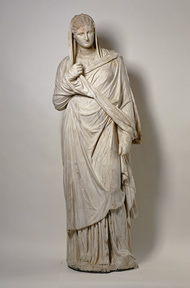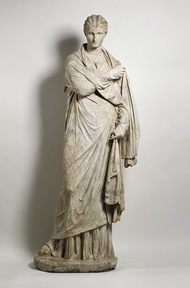| Exhibitions | ||
| Collection | ||
| Education | ||
| Research and Conservation | ||
| Publications | ||
| Games | ||
| Public Programs | ||
| About the J. Paul Getty Museum | ||
| Explore Art Home |

|
|
Two life-size Roman sculptures, known as the Large and Small Herculaneum Women, are on loan to the J. Paul Getty Museum at the Getty Villa from the Dresden State Art Collections through October 13, 2008. They are installed in the Women and Children in Antiquity gallery on Floor 2. Related events are listed below.
About the Herculaneum Women
Unearthed in 1711, the Herculaneum Women were the first significant finds at ancient Herculaneum, and they are among the best preserved of all the sculptures found there. Their discovery and legacy were explored in the recent exhibition The Herculaneum Women and the Origins of Archaeology.
The Herculaneum Women and Roman Sculpture
The Herculaneum Women are Roman versions of sculptural types deriving from Greek art. They have idealized facial features, wear elegant, enveloping drapery, and share the same distinctive hairstyle, the so-called melon coiffure, which became fashionable in Greece after 350 B.C., when the models for the Herculaneum Women were created. The melon coiffure is represented in several other sculptures in the Museum's collection, such as a Greek Head of a Young Woman from a Grave Monument.
The third Herculaneum Woman, which did not travel to the Getty Villa, was missing its head when it was found. Her portrait head, probably with individual features, was carved separately for insertion into the neck cavity, similar to another portrait statue of a Woman in the Getty's collection.

|
|
Who Are the Herculaneum Women?
The Large Herculaneum Woman, shown above, represents a matron and has part of her mantle pulled up over her head, signifying piety. The Small Herculaneum Woman, shown at right, depicts a younger woman pulling the end of her mantle up over her shoulder in a gesture of modesty. These body types were widely used for portraits of Roman women, but the two types have rarely been found together.
Who did the Greek models of these figures represent? Possibly goddesses or muses, although the sculptures lack any attributes that link them to characters from mythology. More likely they were portraits of priestesses, poets, or other eminent Greek women.
The Roman figures from Herculaneum are equally difficult to identify, though their theater setting provides a clue. In Roman cities, theaters were a common place for the display of honorific statues of patrons and benefactors of the community. The Herculaneum Women may thus have represented members of the local elite.
The Herculaneum Women in Ancient Art
The Herculaneum Women are the most prevalent images of the draped female form in the classical world. Their elegant, enveloping drapery and composed stance represented feminine virtues of beauty, grace, and decorum in both Greek and Roman societies. More than 180 examples of the large statue type and over 160 of the small statue type are known, along with dozens of variants and reliefs on tombstones and sarcophagi.
The majority of the figures are combined with individualized portraits. The J. Paul Getty Museum's collection alone contains four of these sculptures, including a monumental portrait of the empress Faustina the Elder with the body of the Large Herculaneum Woman and three fragmentary female statues in the Small Herculaneum Woman type. They all date to the second century A.D., when the Herculaneum Women body types were most popular.
![]()
All events are free unless otherwise noted. Admission to the Getty Villa is FREE. An advance, timed ticket is required. Tickets are available online or by calling (310) 440-7300. Groups of nine or more must make reservations by phone.
Lecture
Copiez la femme: Replicated Bodies and Individuality in Roman Portraiture
Roman portraits are famous for highly individualized renderings of their subjects. But often, portrait heads are combined with bodies copied from a limited repertoire of statue types. How does this influence our interpretation of the work? Annetta Alexandridis, professor of classical art and archaeology at Cornell University, examines the Herculaneum Women as a case study to explore this question. Free; a ticket is required.
![]()
Thursday, January 10, 2008, 8:00 p.m.
Getty Villa, Auditorium
Tours and Talks
Focus Tour: Herculaneum Women
Enjoy learning about the Herculaneum Women with the behind-the-scenes perspective of a Getty curator in this one-hour tour. Free with your advance, timed ticket to the Getty Villa. Space is limited. Sign up at the Tour Meeting Place outside the Auditorium 15 minutes before the talk.
Monday, January 28, 2008, 3:00 p.m.
Monday, February 25, 2008, 3:00 p.m.
Monday, March 31, 2008, 3:00 p.m.
Getty Villa, Museum galleries
Point-of-View Talks
Los Angeles artist Alexander Mihaylovich, whose paintings explore museological practice and the objectification of history, discusses recent work with images of the Herculaneum Women and their archaeological discovery. Free with your advance, timed ticket to the Getty Villa. Space is limited. Sign up at the Tour Meeting Place outside the Museum Main Entrance 15 minutes before the talk.
Thursday, January 17, 2008, 11:30 a.m. and 3:00 p.m.
Thursday, February 14, 2008, 11:30 a.m. and 3:00 p.m.
Saturday, February 16, 2008, 11:30 a.m. and 3:00 p.m.
Getty Villa, Museum galleries